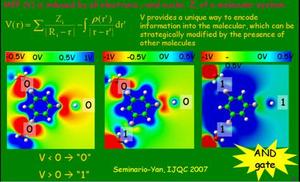DetectionMolecule “scanner” uses terahertz radiation to identify single molecules
Molecules could soon be “scanned” in a fashion similar to imaging screenings at airports, thanks to the world’s smallest terahertz detector, developed by University of Pittsburgh physicists. The scanner has the ability chemically to identify single molecules using terahertz radiation — a range of light far below what the eye can detect.

A unique way to encode information into the molecular // Source: tamu.edu
Molecules could soon be “scanned” in a fashion similar to imaging screenings at airports, thanks to a detector developed by University of Pittsburgh physicists.
A University of Pittsburgh release reports that the detector, featured in a recent issue of Nano Letters, a publication produced by the American Chemical Society, may have the ability chemically to identify single molecules using terahertz radiation — a range of light far below what the eye can detect.
“Our invention allows lines to be ‘written’ and ‘erased’ much in the manner that an Etch A Sketch toy operates,” said study coauthor Jeremy Levy, professor in the Department of Physics and Astronomy within the Kenneth P. Dietrich School of Arts and Sciences. “The only difference is that the smallest feature is a trillion times smaller than the children’s toy, able to create conductive lines as narrow as two nanometers.”
Terahertz radiation refers to a color range far beyond what the eye can see and is useful for identifying specific types of molecules. This type of radiation is generated and detected with the help of an ultrafast laser, a strobe light that turns on and off in less than thirty femtoseconds (a unit of time equal to 10-15-of a second). Terahertz imaging is commonly used in airport scanners, but has been hard to apply to individual molecules due to a lack of sources and detectors at those scales.
“We believe it would be possible to isolate and probe single nanostructures and even molecules — performing ‘terahertz spectroscopy’ at the ultimate level of a single molecule,” said Levy. “Such resolution will be unprecedented and could be useful for fundamental studies as well as more practical applications.”
Levy and his team are currently performing spectroscopy of molecules and nanoparticles. In the future, they hope to work with a C60, a well-known molecule within the terahertz spectrum.
The oxide materials used for this research were provided by study coauthor Chang-Beom Eom, Theodore H. Geballe Professor and Harvey D. Spangler Distinguished Professor at the University of Wisconsin-Madison College of Engineering.
The research was supported by grants from the United States Air Force Office of Scientific Research and the National Science Foundation.
— Read more in Yanjun Ma et al., “Broadband Terahertz Generation and Detection at 10 nm Scale,” Nano Letters 13, no. 6 (21 May 2013): 2884–88 (DOI: 10.1021/nl401219v)
